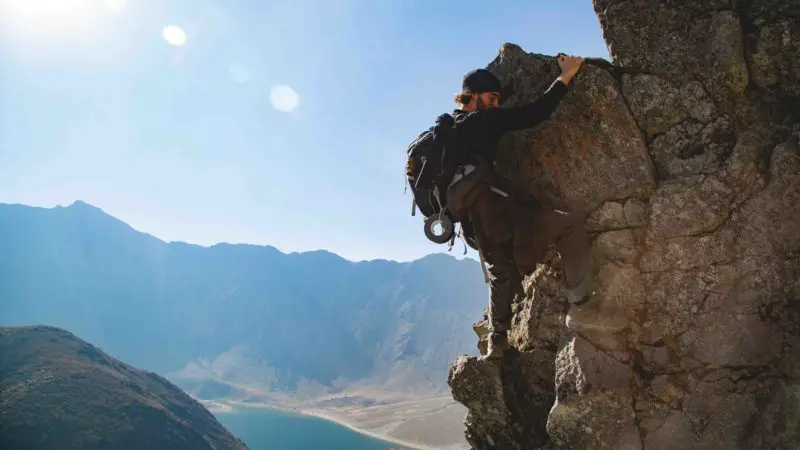If you had told me 5 years ago that I’d become an avid climber, never missing a chance to get on the crag every weekend, I would have laughed at you. I was terrified of heights to the point where it would paralyze me. I’d grab the ladder from the garage to change a bulb way up on our arched ceilings, and I’d head up a few rungs to become petrified with fear.
It almost seems silly, doesn’t it? But I won’t laugh at you because I get it. I know what it feels like to be so frightened from climbing even just a few feet off the ground; that fear comes from deep within. We know what gravity is and what happens when we test that out.
What motivated me to climb was a bet I’d made with my best friend who had been climbing since we first met back in college. I lost the bet, and I had to go climbing with him. Granted, it was just at the gym, but it was still terrifying. So, what changed that now has me higher than I ever expected to be, outside of an airplane?
The short answer: I discovered what my fear was all about.
I had to dig deeper to find out the reason behind my fear. And when I did, I realized that it wasn’t so much about the heights, because you can boulder and stay lower, as I found out. It was that I was scared of falling to my death. The thing that surprised me the most though was that I met other climbers who started out just as frightened as me. I think that’s what made me want to take it to the next level — that, and the fact that I had to go through with my end of the bargain.
Where does the fear response come from?
There seem to be two types of people in this world: those who embrace heights, standing out on the edge of a cliff proclaiming, “Isn’t this just fantastic?” as they edge closer for a better look, and those who stand as far away from that cliff as they can, perhaps gripping something like a nearby tree for moral support. You can guess which type I was.
That fear of heights makes your stomach pitch and fills your head with a chorus of “I can’t” on replay. It’s a hard one to defend simply because when you’re in that state of fear, your body’s normal reactions to either fight or flight aren’t all that useful. Instead, you’re left frozen in fear, sometimes physically, where you’ll need to be talked out of that panic.
Knowing where that fear comes from and calming it is the first step to take before you start climbing. Then, you can move ahead in one of two ways, by heading into it at the extreme or taking it in baby steps. Everyone is different here, and you’ll have to go with what makes sense to you. For me, it was baby steps all the way.
Trust in yourself and your gear
I used to think my best friend was nuts to suspend himself from a rope, way up off a crag. “Only a crazy person would do such a thing”, I’d think to myself when I’d see his photos up on Facebook after an epic climb.
Then I thought I was crazy for ever entering into such a bet. I was so sure I’d win, that it didn’t even cross my mind that I’d have to go to the climbing wall with him. But once I was there, and I saw the gear and all the equipment, I was a little less tense. My fear slowly began to abate, as I watched others take to the wall. After a brief rundown and getting geared up, I followed my best friend’s lead and listened to everything he said, and I realized that as I concentrated on what I was doing, I was no longer afraid.
I felt safe because I was in a controlled environment with someone I trusted and knew that should I fall off, the gear would keep me from smashing to the ground. I was shown the carabiners, and how much they can support, I had a helmet, and as I was taught about the belay device and the rope, it suddenly felt so much less foreign and frightening. While we kept that first session short and didn’t go all the way to the top, I understood why someone would do this, and suddenly, I was all in.
Start with bouldering
Now that I look back, I can laugh at myself for ever being so tense. It’s not that my fear of heights has gone away completely, but with a trust in the gear and those you’re with, it makes it easier to put that fear of falling aside and just love every thrilling second of it.
But if you’re still terrified, and I don’t blame you, one of the best ways to get into climbing is to start with bouldering. In fact, it’s what I did a couple of times after that initial climb to get more comfortable. In bouldering, you don’t use a rope. You’re not climbing very high, and you’ve got a floor below covered with these thick climbing pads so if you do fall, you won’t risk getting hurt.
Bouldering also allows you to keep parallel with the ground if you wish so you don’t have to go all the way up the difficult routes. It makes trying out climbing a lot less intimidating. You can then test yourself by slowly going just a bit higher and seeing how you feel. Once you get more comfortable, you can get on the climbing wall, and perhaps after that, the crag!
First things first though. Keep bouldering until you feel ready. Then you can hit the climbing wall, staying low and going slowly at your own pace, trying to get a little further each time.
Build your tolerance by steadily climbing higher
I must stress here that I wasn’t suddenly cured of my fear of heights with that first time on the climbing wall. Far from it. But I wasn’t afraid to try it anymore. I was ready to keep going and discovering this sport. My best friend couldn’t have been more thrilled that I was finally getting into this.
What worked for me was to keep gradually building my tolerance for heights. I’d go up only as far as I felt comfortable. At first, I couldn’t go more than 5 feet without asking to be belayed to the ground. Then it was 10 feet, which turned into 20.
With each future climb though, I began getting higher and higher. And once I made it to the top of the climbing wall, I told my best friend I was ready for the outdoor world. “Not so fast,” he’d told me. “There’s one more thing you need to do.”
Practice falling short falls with a Clip Drop
Now, this would again test my fears in a big way. But I highly recommend it because it will prepare you for the great outdoors. My best friend explained to me what he was about to do, and I watched with absolute terror as he dropped from the next anchor. I was just a short drop, but still, my stomach pitched. And it pitched even harder when he told me it was my turn.
But I’d made it to this point and knowing I was well secured; I followed the instructions called out to me. I climbed up, clipped my rope to the next anchor, and then, I dropped.
That rush was insane! And it taught me how to be a better climber. In this controlled environment at the climbing wall, I was able to practice the clip-drop and master it. It should always be controlled and never be a far fall, so you don’t strain the rope or stress your anchors. The more I did it, the more comfortable I got. After that, I knew I was ready to try this out on the rock.
Don’t look down
Perhaps one of the most obvious points I can give you about conquering your fear of heights while climbing is don’t look down. Ever. It sounds so simple, and it is, but it’s true. When you focus on the problem, you forget that you’re high up off the ground.
It was what I relied on when I first started, and something I still do to this day. Looking down, even when you’re an experienced climber, can bring back all those anxious feelings. Should you happen to glance below and tremble with fright, take a deep breath and bring your focus back to what you’re doing. When you do, you’ll again forget how far up you are and remember how far you’ve come.
Now I’ve gotten to the point where I love knowing what the beauty of nature looks like from the point of view of a bird. It’s amazing up there, gazing out from the cliffs and rugged crags. But it took me a while to get there. And you know what? That’s ok, and it was definitely worth it.
No seasoned rock climber is going to laugh at you for your beginning efforts at the gym. In fact, you’re going to find a welcoming community of people who will encourage you and watch your back. When you know everyone is looking out for you and wants to see you do well, it also helps quell your fears.
Conclusion
Few people are ever naturals at climbing. It’s not something humans were programmed to do. Plus, with gravity, it kind of works against us. Climbing equipment is sturdy stuff though that goes through tons of safety checks and has to pass rigourous inspections before being sold. Plus, with a buddy, you have that added security knowing someone is looking out for you.
Now climbing is something I enjoy with my best friend, but even if you don’t know anyone that does it, if it intrigues you, fight that fear and head to your local climbing gym. You’ll be surprised how supportive people are and how much they’ll want to help you ease into it.
There’s no shame in taking it slow. Stay as slow and low as you need to, for as long as you need to. Only move onward and upward when you feel ready. That could be weeks, months, or even a year from now. Time doesn’t matter. What does matter, is perfecting the technique and getting familiar with the sport.
Rock climbing for people with a fear of heights is possible. I’m absolute proof of this. And to think, it was all because I lost a silly bet. If not for that, I’d never have taken the chance. Don’t let your fear of heights, or rather, your fear of falling hold you back, in this, or anything life throws your way.

